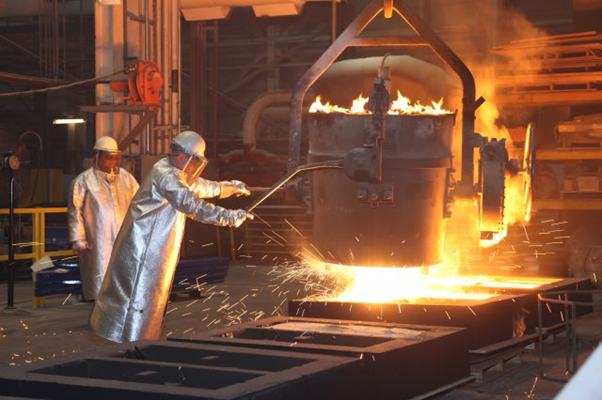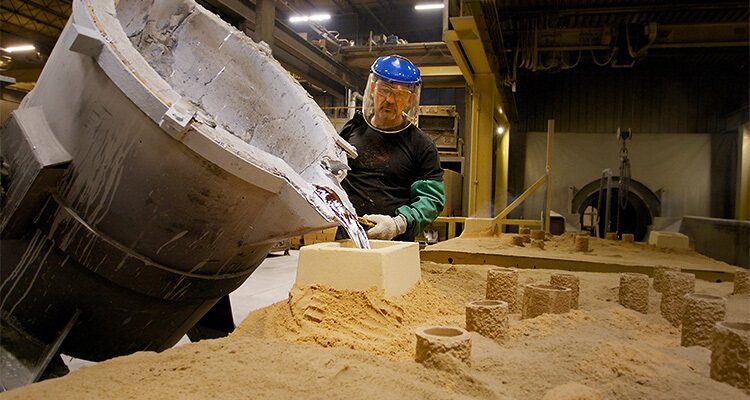Aluminum Foundry and its uses in worldwide industries
Wiki Article
A Comprehensive Guide to the Various Types and Use Aluminum Factory
The globe of light weight aluminum foundry includes different casting methods, each serving unique applications. From the versatility of sand spreading to the precision of die casting, these techniques deal with various production demands. Financial investment spreading provides intricate designs, while permanent mold casting stresses toughness. Understanding the attributes of aluminum alloys is vital for enhancing these procedures. Discovering the nuances of each casting method discloses vital insights for effective task execution. What elements should one consider when choosing the most suitable approach?Review of Aluminum Shop Processes
Aluminum factory processes incorporate a collection of techniques made use of to shape and cast aluminum into various forms. These processes can be generally classified into melting, molding, and completing. The first action entails melting light weight aluminum, commonly done in heating systems that get to heats to achieve a fluid state. When thawed, the aluminum is put right into molds, which define the final shape of the actors item.Numerous molding strategies exist, such as die casting and investment casting, each offering distinct advantages depending on the wanted precision and intricacy of the final product. After the aluminum has actually cooled and strengthened, the casting goes through finishing processes, which might include machining, surface treatment, and assembly. These steps guarantee that the end product fulfills certain tolerances and surface high quality standards. With each other, these processes create a complete technique to aluminum casting, accommodating diverse industrial applications and item demands.
Sand Casting in Aluminum Foundries
Sand spreading is an essential procedure in light weight aluminum factories, characterized by its use of sand molds to shape liquified metal. This method uses a number of benefits, including cost-effectiveness and convenience, making it appropriate for a vast array of commercial applications. Recognizing the ins and outs of the sand casting process is important for enhancing manufacturing and achieving wanted product homes.Sand Spreading Refine Overview
The sand casting procedure serves as an essential approach in light weight aluminum shops, facilitating the production of complex steel components. This process begins with the preparation of a sand mold and mildew, which is formed by compacting sand around a pattern that stands for the end product. Once the mold and mildew is constructed, molten aluminum is put right into the dental caries, allowing it to materialize. After cooling down, the mold and mildew is broken away to disclose the actors component. Sand casting is noteworthy for its adaptability, fitting various forms and dimensions, from little parts to huge structures. Additionally, this method enables the unification of complicated designs, making it a preferred option for numerous industries requiring personalized aluminum parts.Benefits of Sand Casting

Applications in Industries
Casting procedures play an important role in different sectors, with sand casting being a popular technique for aluminum applications. This strategy is extensively utilized in vehicle production, permitting the manufacturing of engine blocks, transmission situations, and different architectural parts. In addition, the aerospace sector leverages sand casting to create lightweight yet durable components, adding to sustain efficiency and performance. The electric market likewise profits from sand-cast light weight aluminum elements, such as housings and enclosures, which provide robust security for delicate devices. In enhancement, the building and construction field employs sand casting for building aspects and fixtures, showcasing aluminum's versatility. Generally, sand casting in aluminum factories offers numerous markets, conference varied requirements while optimizing material residential properties and manufacturing efficiency.Pass Away Spreading Techniques and Applications
Pass away casting is a precision manufacturing process used to produce intricate steel get rid of high dimensional precision and outstanding surface finishes. This strategy entails compeling liquified light weight aluminum into a mold and mildew under high stress, making sure that even elaborate designs can be replicated with impressive consistency. Two key die spreading strategies are hot chamber and cool chamber pass away casting. Warm chamber pass away casting is appropriate for steels with reduced melting points and permits faster manufacturing cycles, while cool chamber pass away casting is suitable for greater melting point steels and provides higher control over steel circulation.Applications of die spreading span various industries, consisting of auto, aerospace, and electronic devices. Parts such as engine blocks, braces, and real estates take advantage of the strength and light-weight buildings of light weight aluminum. The flexibility and efficiency of die spreading make it a vital procedure in producing premium light weight aluminum parts that satisfy rigorous industry requirements.
Financial Investment Spreading: Precision and Detail
Financial investment casting is a sophisticated production procedure known for its capacity to produce elaborate parts with high precision. This method discovers applications across numerous industries, including aerospace and automotive, where information is vital. The advantages of investment spreading, such as decreased product waste and enhanced surface coating, make it a recommended selection for lots of designers.Refine Review and Techniques
Using investment spreading, producers attain extraordinary accuracy and detailed information in aluminum elements. This process starts with producing a wax pattern, which is coated in a ceramic shell. When the shell solidifies, the wax is thawed and drained, leaving a tooth cavity for the molten aluminum. The aluminum is after that put into the mold and mildew, enabling for great features and complex geometries. After cooling, the shell is escaped, disclosing the light weight aluminum component. Strategies such as vacuum cleaner financial investment spreading boost precision by lowering air entrapment, while stress spreading supplies improved surface finish. This careful procedure not just assures dimensional precision yet likewise lessens material waste, making it an efficient selection for producing premium aluminum components in various markets.Applications in Industries
The exceptional precision and detailed detail accomplished through investment spreading make it a favored method in different markets. This technique is especially popular in aerospace, where parts call for intricate geometries and tight resistances. In the vehicle field, financial investment casting is made use of for generating components like engine this content blocks and transmission real estates, making sure sturdiness and efficiency. Additionally, the clinical industry advantages from investment casting to develop specialized instruments and implants that satisfy strict regulative standards. The versatility of light weight aluminum shop investment spreading allows for the production of light-weight yet solid parts, making it suitable for electronic devices and durable goods as well. On the whole, financial investment casting proceeds to play an essential duty in boosting product high quality across diverse applications.Benefits of Financial Investment Casting
When accuracy and complex detail are extremely important, investment casting attracts attention as a very helpful production method. This method permits the production of intricate geometries with tight resistances, making it suitable for applications requiring high accuracy. The procedure includes developing a wax design that is coated in a ceramic covering, which is after that warmed to remove the wax and set the shell. This results in a mold and mildew that captures great details remarkably well. visit this site right here Furthermore, financial investment casting minimizes material waste, as it can produce near-net shapes, decreasing the need for extensive machining. The flexibility of products made use of, consisting of various aluminum alloys, further boosts its charm, making it a preferred option in sectors such as aerospace and vehicle.Irreversible Mold And Mildew Spreading: Stamina and Resilience
Different casting methods exist, irreversible mold spreading stands out for its ability to generate parts with exceptional strength and toughness. This method utilizes a multiple-use mold and mildew, generally made from metal, which permits rapid heat transfer and enhanced mechanical properties in the cast product. The process results in a fine-grained framework, improving strength while lowering porosity compared to sand casting.Long-term mold casting is especially useful for producing parts calling for high tensile toughness and fatigue resistance, making it suitable for aerospace and auto applications. The regulated cooling rate in the mold and mildews adds to uniformity in the microstructure, more enhancing the sturdiness of the components. Additionally, this method can attain detailed designs and limited resistances, which are crucial in high-performance applications. Generally, long-term mold and mildew spreading uses a trustworthy service for suppliers looking for durable and resilient aluminum elements.
Typical Aluminum Alloys and Their Attributes
Understanding the numerous aluminum alloys is necessary for makers intending to boost performance in irreversible mold and mildew spreading applications. Numerous usual light weight aluminum alloys show unique features fit for specific uses.
For applications needing excellent and lightweight resistance to warmth, the 6061 alloy is preferred for its adaptability and weldability. On the other hand, the 7075 alloy, understood for its high strength-to-weight proportion, is mostly used in aerospace applications. Each alloy gives distinct advantages that manufacturers need to consider to guarantee peak efficiency in their specific applications.
Picking the Right Light Weight Aluminum Shop Refine for Your Project
Choosing the proper aluminum foundry process is vital for attaining suitable cause any production project. Numerous methods, such as sand casting, pass away casting, and financial investment casting, offer unique benefits customized to details requirements. Sand casting is functional and cost-efficient for large components, while die casting succeeds in generating high-volume, dimensionally exact elements. Investment spreading is favored for complex layouts and remarkable surface area finish.Factors affecting the option of process include the preferred intricacy, manufacturing quantity, and budget plan restraints. Additionally, the certain aluminum alloy selected may determine the appropriate procedure, as certain alloys execute much better under specific spreading conditions. Understanding the project's needs and the characteristics of each approach assists in making an informed decision. Eventually, choosing the appropriate light weight aluminum shop process not just boosts item top quality but likewise enhances manufacturing efficiency, resulting in effective end results in manufacturing ventures.
Often Asked Concerns
What Industries Mostly Utilize Aluminum Shop Products?
Light weight aluminum factory products are primarily utilized in the automotive, consumer, aerospace, and building items industries. These markets take advantage of aluminum's light-weight, corrosion-resistant residential properties, making it an excellent choice for numerous applications and components.How Does Light Weight Aluminum Recycling Influence Shop Procedures?
Aluminum recycling significantly enhances shop procedures by decreasing raw product expenses, lessening waste, and advertising sustainability. It permits foundries to create high-grade aluminum items while lowering power consumption and environmental effect throughout the manufacturing procedure.What Are the Environmental Considerations in Aluminum Foundries?
Environmental factors to consider in aluminum read this article foundries consist of power usage, greenhouse gas emissions, waste monitoring, and resource sustainability. Reliable techniques can lessen environmental footprints, enhance reusing initiatives, and advertise cleaner manufacturing methods, ensuring an equilibrium in between industry and ecological health and wellness.Just How Can I Ensure High Quality in Aluminum Castings?
To ensure top quality in aluminum spreadings, one need to implement strict quality assurance actions, make use of accurate molding methods, screen temperature level and alloy structure, and perform detailed inspections throughout the spreading procedure to determine and rectify potential defects. Aluminum Foundry.What Are the Usual Defects in Light Weight Aluminum Castings?
Usual problems in light weight aluminum spreadings include porosity, shrinkage, additions, surface flaws, and dimensional mistakes. These issues can arise from inappropriate mold style, poor putting strategies, or not enough alloy composition, eventually influencing the spreading's overall efficiency and high quality.From the adaptability of sand casting to the accuracy of die casting, these approaches cater to various manufacturing requirements. Investment spreading supplies intricate styles, while permanent mold and mildew spreading stresses strength. Methods such as vacuum financial investment spreading boost precision by reducing air entrapment, while stress spreading gives boosted surface area finish. Different methods, such as sand spreading, die spreading, and financial investment spreading, deal unique advantages tailored to certain demands. Sand casting is economical and functional for large components, while die casting excels in creating high-volume, dimensionally accurate components.
Report this wiki page